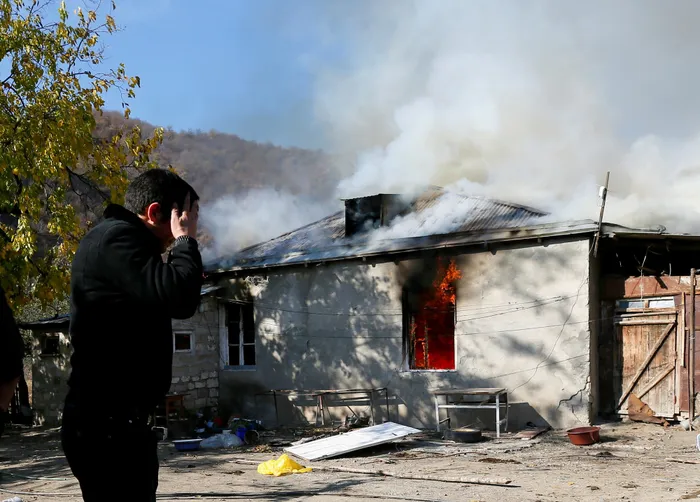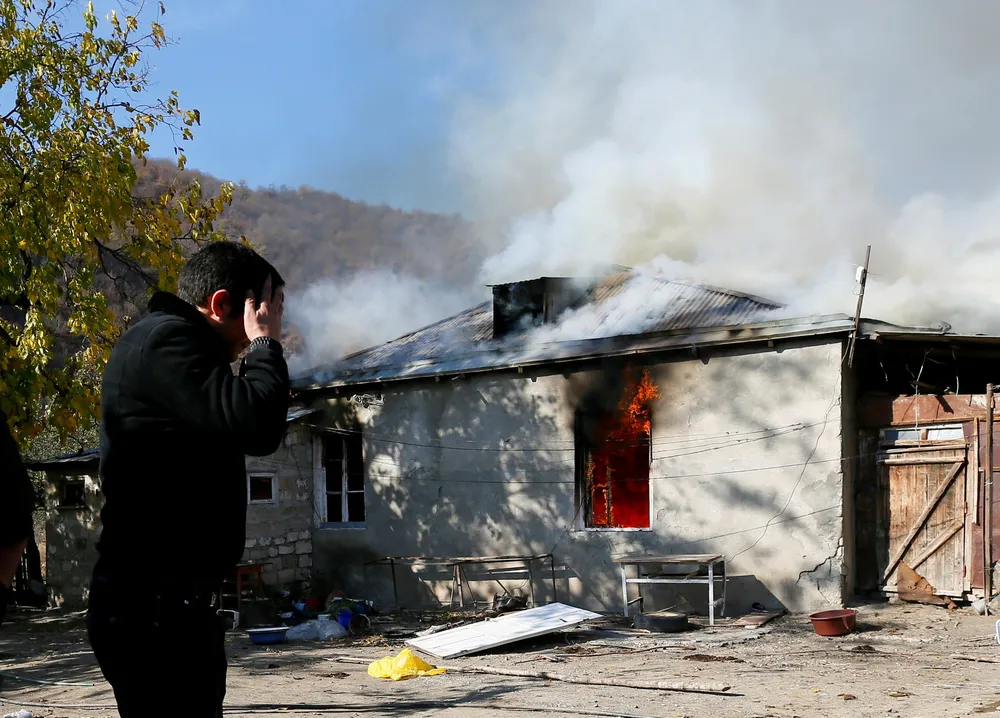Exodus: 60,000 ethnic Armenians flee as Nagorno Karabakh officially dissolves

Picture: Stringer/REUTERS/TPX Images of the Day/November 14, 2020 – A man reacts as he stands near a house set on fire by departing ethnic Armenians, in an area which has been held under their military control but is soon to be turned over to Azerbaijan, in the village of Cherektar in the region of Nagorno-Karabakh.
Picture: via Peoples Dispatch/Taken September 20, 2023 – Nagorno Karabakh region. While the exodus of ethnic Armenians and the dissolution of the self-declared republic may lead to the final settlement of the decades-old conflict in the South Caucasus region, it may also be the beginning of a long geopolitical battle between Russia and the West, the writer says.
By Peoples Dispatch
Samvel Shahramanyan, the president of Nagorno Karabakh’s self-declared republic, issued a decree on Thursday, September 28, announcing its immediate formal dissolution with a promise of dismantling all its “state institutions and their branches by January 1, 2024”, RT reported.
The so-called republic of Nagorno Karabakh, formally known as Artsakh, came into existence when the ethnic Armenian majority in the region — which is internationally recognised as Azerbaijani territory — declared their independence with the support of the Armenian armed forces in 1988 during the final years of the Soviet Union.
During all these years, Azerbaijan has tried to take back control of the so-called republic. Its armed intervention in 1988 led to a long war, lasting till 1994, which ended without any success. During its last major attempt in 2000, Azerbaijan was able to get some territory back, but by and large, the status quo remained, under a ceasefire brokered by Russia.
Azerbaijan was finally able to take full control of the territory last week in a swift “military operation”.
Ever since, thousands of ethnic Armenians have left the region through the Lachin corridor and fled to Armenia fearing persecution and “ethnic cleansing”.

According to Armenian authorities, over 65,000 people had reached the country from Nagorno Karabakh by Thursday morning.
Out of the region’s total estimated population of around 150,000, nearly 120,000 are ethnic Armenians. Armenian Prime Minister Nikol Pashinyan has claimed that all of these ethnic Armenians are expected to leave Nagorno Karabakh for Armenia.
Nagorno Karabakh’s presidential decree advised the Armenians to decide whether they want to stay back despite Azerbaijani leaders expressing hope of reintegration.
“The population of Nagorno-Karabakh, including those outside the Republic, after the entry into force of this decree, should familiarise themselves with the conditions of reintegration presented by the Republic of Azerbaijan in order to make an independent and individual decision on the possibility of staying (returning) in Nagorno Karabakh,” the decree said.
Geopolitical battleground
The Nagorno Karabakh incident has provided a major opportunity for the US to get a foothold in the South Caucasus region, considered strategically significant for Russia.
Pashinyan has already openly criticised Russian peacekeeping forces for their “failure” to prevent Azerbaijan’s military operation last week, and announced the reconsideration of Armenia’s membership to the Collective Security Treaty Organisation (CSTO).
The CSTO is a collective security organisation formed in 2002 with six ex-Soviet countries — Russia, Armenia, Belarus, and the three Central Asian republics of Kazakhstan, Kyrgyzstan, and Tajikistan.
Pashinyan had earlier questioned Russia’s ability to provide security guarantees to CSTO members citing its engagement in the war in Ukraine.
Russia sees Pashinyan’s criticism of its peacekeepers in Nagorno Karabakh as motivated. The Russian Foreign Ministry has alleged that Pashinyan is targeting Russia to appease US and EU leadership, to whom he has been moving closer for some time now.
Russia also alleged that despite an ongoing peace process with Baku over Nagorno Karabakh, the Armenian government brought Western powers into the regional conflict by participating in a parallel peace process in Brussels and other European cities earlier this year. During these meetings, Yerevan allegedly recognised Baku’s sovereignty over the territory, leaving the Russian peacekeepers in limbo.
Within hours of Pashinyan’s speech, two high level US officials — the head of USAID, Samantha Power, and acting Assistant Secretary of State for Europe and Eurasian affairs, Yuri Kim — visited Yerevan, giving weight to Russian allegations.
Armenia also recently conducted a joint military exercise with the US.
Pashinyan had hinted during his visit to Italy in the beginning of September that Armenia was ready for greater cooperation with the US and the EU.
Russian international relations expect Dr Stanislav Pritchin commented that at a time when Russia-Armenia relations are going down very fast under the leadership of Pashinyan, “it is important for the US to seize the initiative in relations with Armenia, generate as much visibility as possible, and achieve some results to minimise the level of relations between Armenia and Russia; both in defence sphere, and in other areas,” Sputnik reported.
Russia, however, refuses to give up its presence in the region, with Foreign Minister Sergei Lavrov saying that “historically, geographically, geopolitically it is impossible to lose Russia in the sense of completely ignoring its interests” in the region.
This article was first published on Peoples Dispatch
Related Topics: